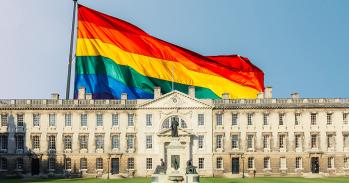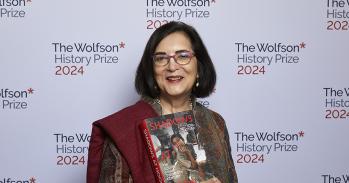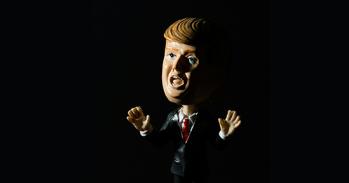
Audiences are spellbound by Meryl Streep’s performance as Margaret Thatcher in The Iron Lady. As a PhD student looking at British politics in the same era, Florence Sutcliffe-Braithwaite was keen to see how the movie portrayed the woman who changed the face of Britain.
Audiences are spellbound by Meryl Streep’s performance as Margaret Thatcher in The Iron Lady. As a PhD student looking at British politics in the same era, Florence Sutcliffe-Braithwaite was keen to see how the movie portrayed the woman who changed the face of Britain.
The film relies on iconic images, without ever getting beneath their skin.
Florence Sutcliffe-Braithwaite
Meryl Streep has won the Golden Globe for best actress for her performance in The Iron Lady, and Oscars are in the offing. In her acceptance speech at Beverly Hills earlier this month, she thanked the British people for letting her ‘come and trample all over’ our history. Her portrayal of Margaret Thatcher is undeniably a great piece of acting. But what else does this film have to offer? As the story of the political career of Margaret Thatcher, the answer is: not much.
The real problem is that the film tends to get details right while neglecting any serious treatment of the big picture. There are some great costumes and sets; the famous hand bags, the voice and style make-over; theatre director Ronnie Millar’s coaching – he advised her on her public image, and worked on many of her famous speeches.
In a brilliant early scene, Thatcher tries to make herself heard in one of Edward Heath’s Cabinet meetings. Heath was her predecessor as leader of the Conservative Party, and Prime Minister between 1970 and 1974. Heath is making woolly, consensualist noises; Thatcher attempts to interject: she suggests that governments should not see it as their job to work with trade unions and bosses to run the country – it’s inefficient. Government should be tougher on the unions. It’s difficult for her to make herself heard, though, because of where she’s seated. This is both funny and accurate: Heath did indeed (according to Jim Prior, who served in both their Cabinets) place Thatcher at the far, right-hand end of the table, out of his eye-line, for he disliked her interventions.
But this brief statement of Thatcher’s political convictions is about as close to politics as the film likes to get. Her beliefs, therefore, seem to amount to little more than a vague sense that governments should be stauncher. In fact, Thatcher (along with important colleagues and think-tanks) developed an increasingly radical set of political ideas during the late 1970s. I’ve studied the Methodist moralising and neo-liberal theorising that lay beneath Thatcher’s ideas about reform of the tax-benefit system in the 1970s. Other historians have explored the vigorous debates over monetarist economic policy, the ‘right to buy’ council houses, privatisation of state industries, and a host of other policies which grew out of Thatcher’s beliefs. She had a vision of a revitalised Britain, which involved a moral society and a booming economy. It’s a shame that none of this could be shown in a montage, the film’s technique of choice for quickly covering long periods of time.
An early scene shows a plucky teenage Margaret making a daring night-time foray from the family air-raid shelter to cover the butter, in an air raid over Grantham in the Second World War. As Thatcher notes in her autobiography, the family had no garden, and hence no Anderson shelter, in their home in small-town Lincolnshire. They used to hide under the kitchen table. There were 21 air raids on Grantham, and this made the town pretty safe compared with many places in Britain. In fact, Thatcher’s mundane wartime existence was one of the things that set her apart from her male colleagues in parliament in the years after 1959 – most had seen service.
The film dwells on the battles Thatcher had to win to gain a foothold in the Tory party in the 1950s. The feisty wannabe-candidate makes some defiant responses to class and gender prejudice, in scenes which convey with some feeling the straight-laced atmosphere of 1950s Britain, and the cosy fug of Conservative constituency parties (as another Tory MP, Alan Clark, put it in his diaries, they tended to be ‘boring, petty, malign, clumsily conspiratorial and parochial to a degree that cannot be surpassed in any part of the United Kingdom’). But the audience is expected to be on the young Thatcher’s side simply because she is a strong young woman whose ambitions cigar-smoking men want to thwart; there is no exploration of the political beliefs which she championed. She seems to have simply inherited naked ambition from her father, Alderman Roberts.
As for Thatcher’s path from a seat in Heath’s Cabinet to toppling him as leader of the party, it’s all over rather quickly. This is a shame, as the machinations which saw her elected as leader of her party are worthy of the backstabbing world of Armando Iannucci’s political drama, The Thick of It. There were two alternative candidates who had to drop out; one because of shady city dealings (Edward du Cann), the other because of a speech which seemed to imply a eugenicist agenda (Keith Joseph – who, along with the equally influential Nigel Lawson, never makes a proper appearance). Thatcher’s campaign manager, Angus Maude, hated Heath and ran a brilliant whispering campaign, telling many MPs that Thatcher was simply a stalking horse, and that once she’d got enough votes to take the ballot into a second round, more congenial candidates would emerge. But Thatcher won so many votes in the first ballot that she seemed to have unstoppable momentum, and the other candidates who came forward had missed the boat. Thatcher won an outright victory in the second round. The big question is: was this just a historical accident with momentous consequences, or did it reflect an underlying trend among back-bench Tory MPs towards a moral populism of the sort that Thatcher stood for? Historical debate still thrives on this subject. But the film doesn’t even begin to tell the tale of this great political intrigue.
Airey Neave, Thatcher’s Shadow Secretary of State for Northern Ireland in the late 1970s, is portrayed as a second father-figure, his voice echoing through the film, telling Thatcher to ‘stay true to herself’. This is the sort of self-centred mumbo-jumbo that one can imagine Thatcher giving short shrift to. Indeed, one of the only good (and funny) moments of the film sees the aged Thatcher deliver a short, sharp homily to her doctor on the importance of thoughts, and the ridiculous 21st century obsession with feelings. What a pity her thoughts, ideas, and convictions are given so little airtime.
Archive footage of riots and police brutality is used to good effect. Scenes of swirling crowds of protesters and ranked masses of police officers make for shocking viewing. But what’s more shocking is that viewers learn little about the context or causes of these scenes. Striking miners, IRA terrorists, rioters in Brixton in 1981, protesting against poverty and police discrimination; there is little exploration of what led these groups to oppose, often violently, Thatcher’s government. Perhaps it would be too much to ask a feature film to depict Thatcher’s policy of incremental trade union law reform. But the film could have shown some of the complexities of the miner’s strike, for example, instead of using the renegade miners’ leader Arthur Scargill as the all-too-obvious cartoon villain. Billy Elliot, which was about a boy who wanted to be a ballet dancer, explored the meanings of community and family to a working-class mining town in the 1980s. I expected more from a film that puts Thatcher herself firmly at centre stage.
The film relies on iconic images, without ever getting beneath their skin. I once heard Chris Collins, the tireless director of the Thatcher Foundation website, which contains a wealth of sources for the student of Thatcherism (including copies of almost every public speech Thatcher ever made), talk about watching the rushes from the informal interview Thatcher did with John Cole, at about 4 am after the Brighton hotel bombing in 1984. He described how uncertain and shocked Thatcher looked, with her husband Denis beside her. Cole asked her if she had any message for people at breakfast time; whether the conference would go on. Thatcher spoke somewhat hesitantly, and for a moment she looked as if she was unsure whether the camera was on; then the lights brightened, that famous resolve returned, and she made the statement that would become famous: ‘The conference will go on, as usual’. It is this sort of thing which bolstered the ‘Iron Lady’ image. The film does little to try to penetrate that image, relying on a crude pathos inspired by the scenes of an elderly Thatcher.
Screenplay author Abi Morgan has said that she wanted to write a film about dementia. That might well be a laudable desire. Dementia affects more and more people, directly and indirectly, as we live longer. It’s still not understood widely enough, and the NHS doesn’t always have the appropriate facilities or staff to deal with it. These are all issues which could be explored sensitively and movingly in a film about dementia. But why, then, make a film about Thatcher? There are so many dramatic, important, and controversial moments in her political career which deserved to get a real airing. At the end of the film, I couldn’t help but think that this was a wasted opportunity.
Florence Sutcliffe-Braithwaite is writing a PhD about Britain in the 1970s, supervised by Dr Jon Lawrence. She is a member of St Catharine’s College, Cambridge. Her work on ‘The neo-liberal and moral roots of Thatcherite social policy’ will be published in the Historical Journal during 2012.
This work is licensed under a Creative Commons Licence. If you use this content on your site please link back to this page.





